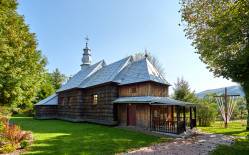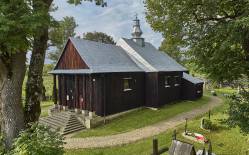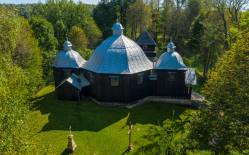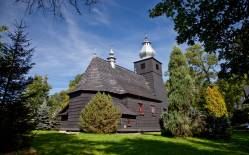The earliest information about a tserkva existing here is found in a tax register from 1589. The church which we can see now, the former Greek-Catholic Tserkva of Archangel Michael, was built in 1862.
After 1951 the building was used for charcoal storage. In 1971 it was acquired by the Roman Catholic parish and was thoroughly restored. Today it functions as a filial Roman Catholic church of St. Anthony.
This three-part log church, is oriented eastward and comprises a small porch leading to the narthex. The chancel is adjoined by the sacristy on the southern side. The whole building is covered with shingles, the roof is clad with sheet metal, and the tower is lined with vertical wood planks. Each part of the building is covered with a gable roof. The main entrance to the porch, added more recently, replaced an older one situated on the northern side.
Inside, there is an open beam ceiling. The old wall paintings were not preserved. The only original furnishings here include the icons of Hodegetria-type Holy Mother and Child, Christ as well as Christ Pantocrator, in the neo-Baroque side altars. The first two are sovereign icons, while the Pantocrator originally was in the Deisis row. They are credited to Illia Detsyk from Sambir, an artist active in the first half of the 1900s.
Next to the church there is a zvonnitsa-type belfry with a relief depicting St. Anthony.
On the other side of the Łodynka stream, 500 metres south of the church there is an area called Roweń, where older tserkvas were located.
Photo: Krystian Kłysewicz
Gallery

Recommended venues on the Trail



This website has been modernized with the financial support of the European Union under the Cross-Border Cooperation Programme Poland-Belarus-Ukraine 2014-2020. The responsibility for its content lies solely with the Podkarpackie Regional Tourism Board and cannot, in any case, be treated as a reflection of the position of the European Union, the Managing Authority, or the Joint Technical Secretariat of the Cross-Border Cooperation Programme Poland-Belarus-Ukraine 2014-2020.













